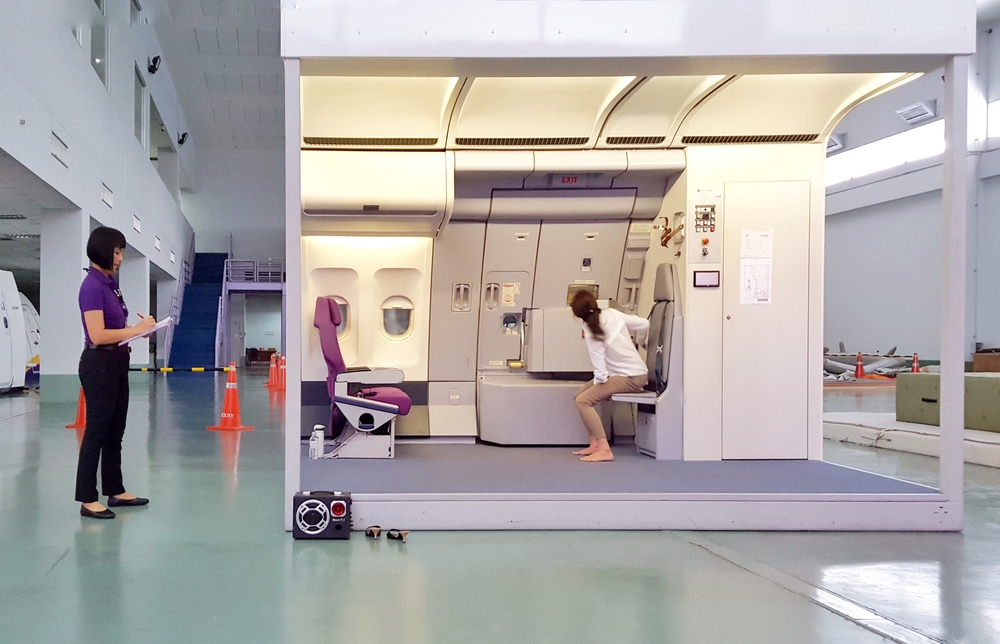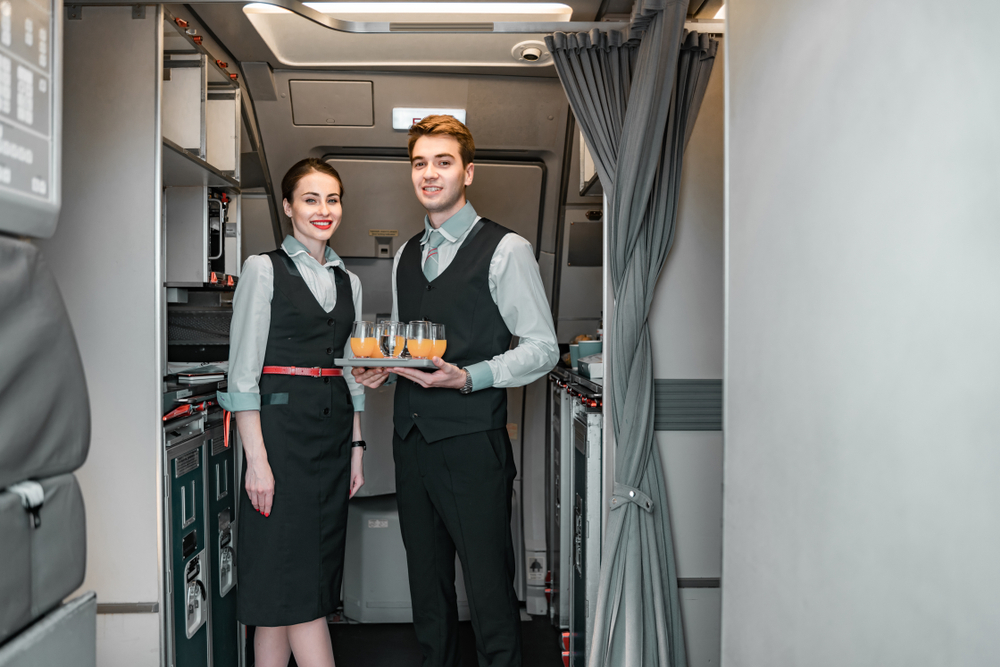The dream of becoming a flight attendant often comes with a host of misconceptions. Myths about cabin crew jobs often stem from misunderstandings and stereotypes. Understanding these realities is crucial for anyone considering a career in this field. But what and why do people often get wrong about the cabin crew career and duties?
Here is a breakdown of the top 10 myths about the cabin crew career and where they come from. We will break them down and reveal the facts. This article will give you a clearer, more accurate picture of what life as a flight attendant is truly like.
Table of Contents
Myth 1: Cabin crew are just waitresses in the sky
Myth: One of the most persistent myths about a cabin crew career is that flight attendants are simply waitresses in the sky. But is this true? Many people assume that serving food and drinks is all there is to the job.
Origin: This myth likely comes from the visible aspect of the job — meal service — without recognizing the extensive safety and emergency responsibilities.
Reality: While serving food and drinks is part of the job, it is far from the whole story. Flight attendants play a crucial role in ensuring passenger safety and managing emergency procedures. They constantly train to handle everything from medical emergencies to evacuation procedures, making their responsibilities far more complex than just meal service. There is no doubt that the cabin crew job requires a specific set of skills!
The next time you hear this myth, remember that cabin crew members are highly skilled professionals dedicated to both comfort and safety!
Myth 2: You need to be young and single to be a flight attendant
Myth: Many people believe that only young, single individuals can become cabin crew members. But is that really true?
Origin: This idea likely comes from the early days of aviation when airlines had strict, outdated rules. Back then, airlines often preferred younger candidates. Air carriers saw them as more adaptable to the demanding travel schedule. Also, societal norms favored single individuals, as the job’s irregular hours and frequent travel were thought to be incompatible with family life.
Reality: Over time, these views have changed a lot. Today, airlines value experience and maturity. Air carriers know that skills and reliability are more important than age or marital status. Modern cabin crews are diverse, with members of all ages and family situations.
So, if you are passionate about becoming a flight attendant, do not let your age or marital status stop you! Airlines want dedicated professionals who can excel in the role, no matter their personal circumstances.
Myth 3: Flight attendants live a glamorous lifestyle
Myth: Some people believe that flight attendants live a glamorous lifestyle. They think this includes jet-setting around the world, staying in luxurious hotels, and enjoying endless travel perks.
Origin: The idea of a glamorous flight attendant lifestyle likely started in the early days of commercial aviation, especially in the 1950s and 1960s. Back then, air travel was a luxury only a few could afford. Airlines marketed their services as exclusive and high-end. Flight attendants, often called “stewardesses,” were shown in ads as elegant and sophisticated, adding to the allure of flying.
Hollywood also played a big part in spreading this image. Movies and TV shows often showed flight attendants living exciting lives full of adventure and romance. This portrayal made the job seem all about glamor, style, and luxury. Flight attendants wore fashionable and chic uniforms back then. This made the job seem glamorous. As a result, this image of the job has persisted for years.
Reality: The reality of cabin crew jobs includes long shifts, irregular hours, and frequent time away from home. Flight attendants often face challenging schedules and demanding work environments. The glamor associated with the job often masks the hard work and dedication required to manage a successful career in the skies.

Myth 4: Cabin crew only work on the plan
Myth: People often believe that cabin crew only perform their duties while in the air.
Origin: This myth arises because the in-flight tasks are the most visible.
Reality: However, cabin crew also handle pre-flight and post-flight duties. Pre-flight briefings, safety checks, and post-flight duties are all part of the job. This comprehensive role ensures that everything runs smoothly and safely, both before and after the flight. Understanding these additional tasks helps clarify the full scope of a flight attendant’s job.
Interested in soaring into a cabin crew career? Discover tips and essential steps you need to take off in this exciting field.
Myth 5: Cabin crew job is easy and requires no special skills
Myth: Another common myth is that the cabin crew job is simple and does not need special skills.
Origin: This myth likely stems from not seeing the behind-the-scenes training. The varied skills required for emergency situations and customer service also go unnoticed.
Reality: The reality is that the job demands extensive training and a wide range of skills. Flight attendants undergo rigorous training in emergency procedures, medical responses, and customer service. They must also handle the physical and emotional demands of the job. For example, managing in-flight issues or dealing with challenging passengers.
The next time someone suggests the job is simple, remind them of the specialized training and skills required! Learn how to kick-start your career as a flight attendant here.
Myth 6: Flight attendants have unlimited free travel
Myth: There is a belief that flight attendants get to travel for free all the time.
Origin: While they do benefit from travel perks, these come with certain restrictions. Those limitations and conditions are not always clear to the public.
Reality: Standby travel is common, meaning that flight attendants may not always get a seat on their preferred flight. Additionally, free travel benefits often come with conditions and are subject to availability.
Myth 7: All flight attendants are female
Myth: The idea that only women can be cabin crew is outdated.
Origin: This stereotype comes from old norms and media portrayals.
Reality: The aviation industry now welcomes gender diversity. More men are becoming cabin crew members. Airlines focus on skills and dedication, not gender.
Myth 8: Cabin crew don’t need higher education
Myth: Some people think cabin crew members do not need higher education.
Origin: Why did this myth start? It dates to the early days of aviation. Back then, flight attendants did not need advanced degrees. Airlines focused more on appearance and basic service skills rather than education. People thought airlines hired flight attendants mainly for their looks and charm.
Reality: What is the truth today? Airlines understand that advanced qualifications make flight attendants perform better. Many air carriers prefer candidates with higher education or specialized training in areas like customer service, aviation safety, and medical assistance. Isn’t it clear that the role has evolved beyond just charm and looks?
Curious about what it takes to join the cabin crew ranks? Check out the entry requirements and see if you have got what it takes to take flight!
Myth 9: Flight attendants often face harassment from passengers
Myth: The idea that flight attendants face constant harassment from passengers is a misconception.
Origin: Media stories and isolated incidents spread this myth. They do not reflect the complete training and support that flight attendants receive.
Reality: Airlines put strict protocols and support systems in place. They train cabin crew to handle tough situations and keep the work environment safe. Although challenging interactions can happen, the industry focuses on protecting and supporting its staff.

Myth 10: Cabin crew have no career growth
Myth: Finally, the myth that flight attendants have limited career advancement opportunities is simply not true.
Origin: In the past, people viewed cabin crew as having only one job with few chances for promotion. Early on, the role seemed limited to serving passengers. Media and popular culture supported this view, showing flight attendants in fixed roles with little room for growth.
Reality: Today, the airline industry provides many career paths. Flight attendants can advance to senior positions, training roles, and management. They can grow through experience, extra training, and leadership opportunities.
And there you have it — a full-on myth-busting tour through the exciting world of cabin crew career! From the idea that flight attendants are just sky-high waitresses to the myth of endless glamor and free travel, we have shattered some serious misconceptions. So, next time you are flying high, give a nod to the real magic happening behind those cabin doors! Flight attendants are the unsung heroes of the skies, juggling everything from safety drills to the occasional turbulence with a smile.

